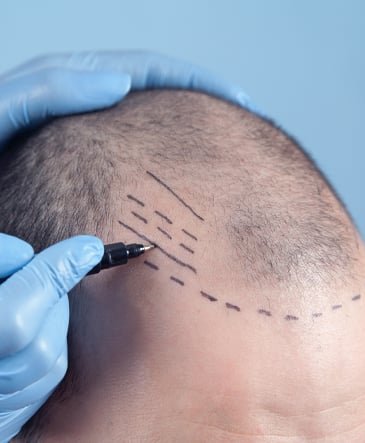
Fut Hair Transplant Surgery
Follicular Unit Transplantation (FUT) is a surgical hair restoration technique that involves harvesting a strip of tissue containing hair follicles from the donor area, typically located at the back or sides of the scalp. This strip is then carefully dissected into individual grafts, which are subsequently transplanted into the recipient area affected by hair loss. FUT allows for the transplantation of a large number of grafts in a single session, making it suitable for individuals with extensive hair loss or those requiring maximum hair coverage. While FUT is an effective procedure, it does involve the creation of a linear scar at the donor site, which may be more noticeable compared to other hair restoration techniques. However, advancements in surgical techniques have minimized scarring and improved overall outcomes, making FUT a viable option for many individuals seeking hair restoration.
What is FUT hair transplant?
Follicular Unit Transplantation (FUT) is a surgical hair restoration procedure known for its efficiency in transplanting a large number of hair follicles in a single session. Unlike FUE, which involves extracting individual follicular units, FUT entails harvesting a strip of tissue from the donor area, typically at the back or sides of the scalp. This strip is then dissected into individual follicular units, which are meticulously transplanted into the recipient area to address hair loss or thinning.
While FUT offers the advantage of transplanting a greater number of grafts in a single session, it does result in a linear scar at the donor site, which may be more noticeable than with FUE.
However, advancements in surgical techniques have minimized scarring and improved overall outcomes, making FUT a viable option for many individuals seeking hair restoration.


Fut Hair Transplant Surgery
FAQs About FUT Hair Transplant

FUT hair transplant boasts a high success rate, typically ranging from 90% to 95%, when performed by skilled surgeons in suitable candidates. Success depends on factors such as patient selection, surgeon expertise, and post-operative care.
FUT hair transplant is performed under local anesthesia, ensuring that patients experience minimal discomfort during the procedure. Some mild soreness and swelling may occur in the days following the surgery, but these can be managed with prescribed medications.
Hair growth following FUT hair transplant is a gradual process, with initial growth starting to become visible within 3 to 4 months post-procedure. Full results are typically achieved within 12 to 18 months, as the transplanted hair follicles continue to grow and mature over time.
The transplanted hair follicles behave similarly to the donor hair, meaning they are permanent and resistant to hair loss caused by male pattern baldness. With proper care and maintenance, the results of FUT hair transplant can last a lifetime, providing natural-looking and long-lasting hair restoration.
In some cases, patients may experience further hair loss in areas surrounding the transplanted follicles over time. In such instances, a follow-up FUT hair transplant procedure can be performed to address these concerns and restore hair density as needed.
Like any surgical procedure, FUT hair transplant carries a minimal risk of complications such as infection, bleeding, or scarring. However, when performed by experienced surgeons in accredited facilities, these risks are rare and can be mitigated with proper pre-operative assessment and post-operative care.
Yes, FUT hair transplant can be combined with complementary treatments such as platelet-rich plasma (PRP) therapy or medical hair loss treatments like minoxidil or finasteride to enhance results and promote hair growth. A comprehensive treatment plan can be tailored to address each patient’s unique needs and goals.
There is no strict age limit for undergoing FUT hair transplant, as candidacy depends more on the patient’s overall health and the extent of their hair loss rather than their chronological age. However, younger patients should be carefully evaluated to ensure that their hair loss pattern is stable and suitable for transplantation.
Most patients can resume their normal activities within a few days following FUT hair transplant, although strenuous exercise and heavy lifting should be avoided for at least a week to minimize the risk of complications. Patients can expect some mild swelling and redness in the treated area, which typically resolves within a week or two.
Yes, FUT hair transplant can be an effective solution for female pattern hair loss, particularly in cases where other treatments have been unsuccessful. However, female patients should undergo a thorough evaluation to determine the underlying cause of their hair loss and ensure that they are suitable candidates for the procedure.
Suitable candidates for FUT hair transplant typically have sufficient donor hair, stable hair loss patterns, and realistic expectations. A consultation with a hair transplant specialist can determine candidacy based on individual factors.
Yes, FUT hair transplant can be used to correct or revise the results of previous hair transplant procedures, including outdated techniques or unsatisfactory outcomes. Skilled surgeons can assess the situation and recommend appropriate solutions.
The number of FUT sessions required depends on factors such as the extent of hair loss, the desired level of hair density, and the availability of donor hair. In some cases, a single FUT session may suffice to achieve satisfactory results, while others may require multiple sessions spaced several months apart to achieve optimal outcomes.
The duration of the FUT hair transplant process varies depending on factors such as the number of grafts needed and the technique used. Generally, the procedure can take anywhere from several hours to a full day, with additional time required for recovery and follow-up appointments.
Before FUT hair transplant surgery, patients are advised to avoid alcohol, smoking, and certain medications that can thin the blood and increase the risk of bleeding during surgery. Additionally, maintaining a healthy diet and staying hydrated can promote optimal healing and recovery.
Patients are typically advised to wait a few days before washing their hair after FUT hair transplant surgery to allow the implanted grafts to settle. Once cleared by their surgeon, patients can gently wash their hair using a mild shampoo and following specific post-operative care instructions.
